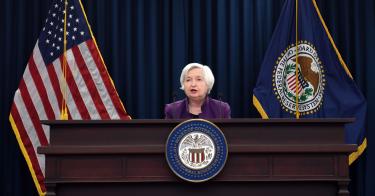Federal Reserve Chair Janet Yellen will give her semi-annual monetary policy report to Congress this week. Expect no great surprises. Still, it will be interesting to see how hard Congress pushes her on the timetable for returning to normal – i.e., pre financial crisis – monetary policy.
As the 2008 crisis unfolded, monetary policy changed dramatically, and the Fed expanded its balance sheet by purchasing trillions of dollars worth of mortgage backed securities (MBS) and long-term Treasuries.
These crisis-inspired policies were a break from the past in at least two ways.
First, the Fed openly admitted that it was not simply providing system-wide liquidity. Instead, it was directly allocating credit to specific sectors by providing “support to the mortgage and housing markets.”
Second, the Fed’s large-scale operations flooded the market with excess reserves, thus removing federal funds rate targeting as the Fed’s main policy tool. (Other Fed operations had nearly killed rate targeting before the Fed officially engaged in quantitative easing; see pages 22 and 23 of the December FOMC meeting transcript).
The policy shift was controversial, and Fed Chair Ben Bernanke repeatedly reassured the public that the moves were only temporary and that the Fed would get back to normal as soon as possible.
Nearly one full decade later, the Fed has yet to announce exactly when it will normalize. Perhaps worse, some policymakers are seriously entertaining the idea of maintaining the Fed’s extraordinary large presence in credit markets, rather than shrinking the balance sheet.
This sort of shift means that the Fed would continue a policy of direct credit allocation and administered interest rates. In other words, the Fed would directly decide who gets credit and where to set key short-term rates rather than allow market forces to do the job. (Contrary to popular opinion, the federal funds rate was determined by market forces – not set by the Fed – prior to these extraordinary policy moves.)
Putting off normalization and maintaining this existing framework is a terrible idea. Congress should force the Fed to start normalizing now, and they should prevent the Fed from doing anything remotely similar again.
Congress has to ensure that this framework becomes a relic because it has completely separated monetary policy tools from the size of the Fed’s balance sheet. In this brave new world, the Fed can conduct monetary policy while purchasing trillions in assets from specific sectors of the economy, all while paying above market interest rates for people to park cash at the central bank.
The Fed, supposedly a lender of last resort, has been transforming into a borrower of first resort.
For all the fancy econ-speak of inflation targets, slack in the labor market, downside risks, financial stability, residential investment, target ranges, normalization, and so on, the policy question is actually quite simple: Does Congress want the private sector or the public sector to allocate credit?
If Congress allows the central bank to continue conducting monetary policy in a way that is divorced from the assets it purchases, it will prevent private markets from allocating credit without (potentially massive) ongoing government interference.
In this new environment, people would normally expect the Fed to hold large market shares of various financial assets.
In the name of financial stability, the Fed could decide to purchase hundreds of billions of dollars in bonds from the financial or housing sectors, as well as the automotive, airline, or construction equipment industries. Just to name a few.
There’s also the ever-expansive credit allocation to the (state, local, and federal) government, thus making it even easier to raise public debt. This framework amounts to permanent off-budget fiscal policy, with even less accountability than exists now.
There is no theoretical limit, and that’s precisely why it needs to be stopped. A few more rounds of this kind of policy, and people will have virtually no incentive to be careful when they invest.
This framework can only lead to grossly distorted prices and interest rates which, of course, magnify boom and bust cycles.
The Fed can barely remain above politics now. It wouldn’t have a prayer of doing so if it continues on the current path because the Fed would serve as a direct spigot of money. The list of advocacy groups petitioning the Fed for favors would top anything ever seen in Washington. And that says something.
Congress can implement a long list of reforms to improve monetary policy, but the immediate task should be getting back to normal.
This piece originally appeared in Forbes: https://www.forbes.com/sites/norbertmichel/2017/07/10/the-federal-reserve-is-at-a-critical-juncture/#6e49a6c569ac



